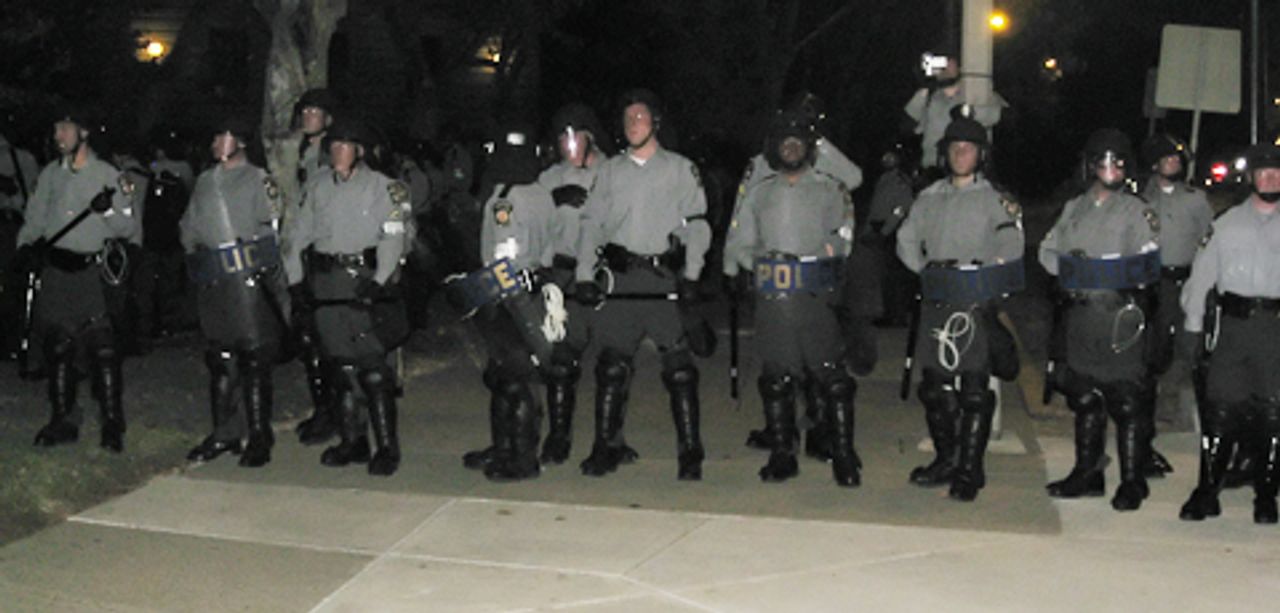Police have carried out a brutal crackdown on demonstrators at the G20 summit meeting in Pittsburgh over the past two days. The virtual lockdown of the city and assault on protesters represents yet another ominous sign of expanding police-military tactics within the United States against individuals protesting government policy.
Over 80 protesters and University of Pittsburgh students have been arrested so far in systematic repression that has included the use of batons, sound cannons, rubber bullets and OC gas (similar to tear gas). In the run-up to the meeting Pittsburgh has been inundated by thousands of police and National Guard troops, while permits for many demonstrations have been denied.

The main clashes with the police took place on Thursday, the first day of the summit. Police fired gas and pellet bags at about 2,000 protesters who gathered at mid-day. They disrupted one march route by cordoning off streets and forcing demonstrators onto side streets.
As the protesters dispersed, police confronted smaller groups. In at least one incident, riot police using batons overtook demonstrators. Protesters and media representatives, including a CNN reporter, were gassed. In another incident, a woman on a bike was pushed by a police officer. When she pushed her bike back, she was quickly thrown to the ground and arrested.
Police used “sound cannons” (also known as Long Range Acoustic Devices), weapons that have previously been used in Iraq and other US military operations. The devices, which emit high-pitched pulses of sound, can cause long-term auditory damage. While they are specified for use only for a few seconds at a time, video evidence shows that riot police used them for far longer durations. This is believed to be the first time that police have used this weapon on civilian protesters in the United States (See video “G20 Lawrenceville Pittsburgh”).
In the evening, police used gas again to disperse a crowd of several hundred protesters near the location of the welcome dinner organized by the Obama administration. According to a UPI report, “Vic Walczak, legal director for the local ACLU, said the crowd was peaceful and even moved when a police car needed to pass through. ‘I don't think this is an unlawful assembly,’ he said.”
The demonstration included many University of Pittsburgh students who were gathered peacefully on a grassy square. According to eyewitness reports, the police advanced on the crowd around 10:30 p.m. and began arresting people and using rubber bullets and OC gas.
Reuters reports, “With no obvious protesters in sight, they sprayed pepper gas on passersby and even students looking down from the balconies of their residences above the avenue.”
Students were told to return to their dorms, and many who were unable to do so in time were arrested. Police in full riot gear entered dormitories to threaten students that anyone arrested would be immediately expelled from school (see video “Riot Police Enter Towers Lobby, Threaten Arrest And Expulsion”).
The events on Thursday followed a number of actions the previous day, including the arrest of fourteen environmental activists who were attempting to hang signs on city bridges.
Luke Ravenstahl, Pittsburgh’s mayor, praised the police for making “swift decisions” and sending the message that the city would not tolerate “unlawful behavior.”
As has become routine at major gatherings such as the G20, the presence of anarchist groups—generally heavily infiltrated by police provocateurs—becomes the pretense for general repression. The thrust of the media commentary was to blame these groups for creating disruptions that necessitated the police response.
The crackdown was prepared well in advance, with more than 4,000 police officers deployed in the city, many transported from states across the country. Among them was a large contingent from Miami-Dade, the site of a police attack on protesters at the Free Trade Agreement of the Americas (FTAA) summit in 2003. Pennsylvania National Guard troops were also deployed.
The main event was fenced off and heavily secured, while sharpshooters took up positions on top of buildings.
Massive repression and the creation of virtual police state conditions have become the norm at major meetings involving the world powers. Earlier this year at a G20 meeting in Britain, police staged a similar action, leading to the death of 47-year-old Ian Tomlinson.
The actions expose the democratic pretenses of the major powers, particularly the Obama administration. Obama has maintained all the anti-democratic measures of his predecessor, including the Patriot Act, domestic spying, and the expanding use of the military in domestic affairs.
Following the June election in Iran, the administration and the American media made much of the crackdown on demonstrators who supported the US-backed opponent of the Iranian government. One can only imagine what the US government and media response would be if the events in Pittsburgh of the past two days were taking place in Tehran.
The G20 summit takes place amidst a mounting economic and social disaster for millions of people around the world. Governments whose leading figures are now gathered in Pittsburgh have responded to the economic crisis that erupted last year by handing out trillions of dollars to the major banks to secure the financial system. Now, the main focus is on curbing costs and forcing the working class to pay for the bad debts of the financial elite.
The world leaders gathered in Pittsburgh are well aware that their policies are increasing social tensions throughout the world—and nowhere more than in the United States. As opposition develops, the response will be to employ more widely the tactics on display this week in Pittsburgh.
